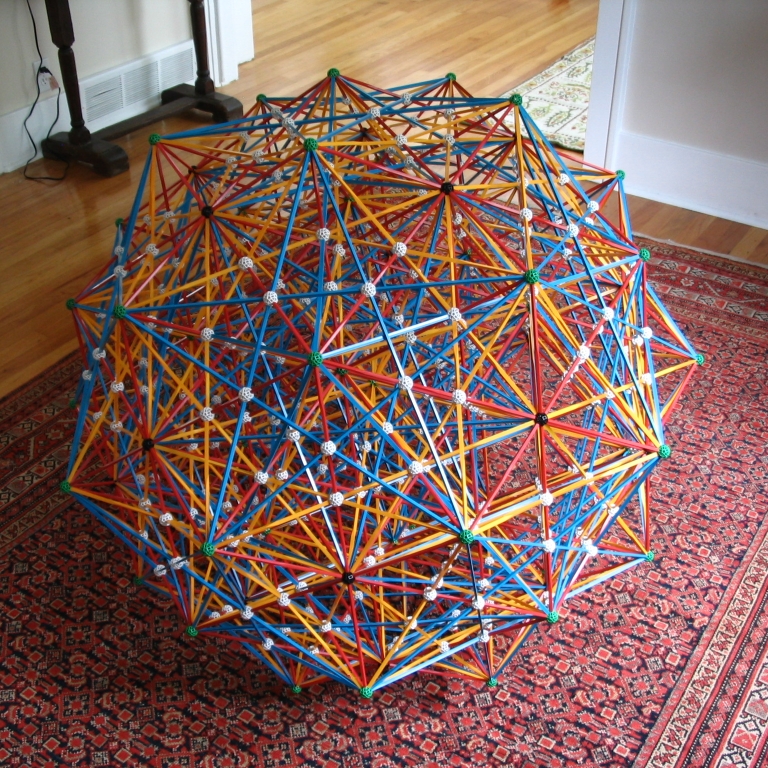a Zome Model

The First Stellation of the 120-Cell, {5/2,5,3}
Introduction.
This and subsequent webpages describe how to make a Zome model of the first stellation of the 120-cell. This is a time-consuming model. Working with a student, it took the two of us about 4 hours to complete.
Arising immediately is a natural question about why such documentation should exist. After all, if the reader has ever heard of the regular polychoron known as the 120-cell, then it is likely that s/he also has some familiarity with the Kepler-Poinsot polyhedra, and can therefore not have much trouble imagining stellating the pentagons of the 120-cell to get the first stellation. Nevertheless, this model possesses some subtleties which the Zome models of the convex regular polychora do not, and it takes some thought and patience to work through these. The target audience is thus: If you have a fair amount of Zome pieces lying around, a little bit of time, maybe with some colleagues or students in a similar situation, you have already built the Zome model of the 120-cell and want a little more, perhaps you could figure out how to build this but don't really want to bother, and you think you can work through all my descriptions of the many required steps, well then, you've come to the right place. If you've never heard of the 600-cell or the 120-cell, then you are advised to proceed at your own risk. Certainly you should build these first. Instructions for the 600-cell are available here.
General Comments.
As you proceed through the directions given, you should always remember that you are building a model of the first stellation of the 120-cell. This polychoron has a total of 720 regular pentagrams, and this is the only type of face one needs. Thus, if you are merrily working along and you notice most of the parts of a pentagram already present in the model, there's a good chance that you need to "complete" it by adjoining more struts. (Recall that one can make a Zome model of a regular pentagram using 10 balls, 10 long blues, and 5 medium blues.) Although the directions below are complete enough to force you to eventually make all of the required pentagrams, there are some occasions where you might be missing some struts. Keep an eye out for this, especially near the end. Another thing to keep in mind is that this polychoron is based on the 120-cell, and that, as a result, a completed model of this polychoron has a copy of the canonical Zome model of the 120-cell imbedded in it. Both of these facts should serve to allow you to check your work.
As you proceed through the directions given, you should also take notice how the orbit-stabilizer
theorem applies. The model constructed here has icosahedral symmetry, so there is a group consisting
of 120 orthogonal
transformations in R3 which preserve the model and such that this group also
preserves the regular icosahedron. We construct this model using a variety of
"elementary modules", each being an assembly
of only a few Zome pieces, and each having its own symmetry group which must be a subgroup
of the icosahedral group. If we can determine the order
of each of these subgroups, then we can determine the number of copies of this module that we must use.
For example, there are a couple instances where we need to make spikes having the same symmetry as
that of the regular pentagon. The group of the regular pentagon has order 10, so we can determine,
using the orbit-stabilizer theorem, that we must use
copies of this spike.
Inventory.
You must have the following parts in the following quantities in order to build this model:| Balls: | 385 |
| Short Reds: | 120 |
| Medium Reds: | 300 |
| Long Reds: | 180 |
| Medium Yellows: | 200 |
| Long Yellows: | 400 |
| Medium Blues: | 180 |
| Long Blues: | 360 |
If you have enough differently-colored balls, then this is certainly a good opportunity to use them. Recall that the stellated 120-cell has two types of intersection points, the 120 vertices where 12 small stellated dodecahedra meet and the 600 "false vertices" which are the vertices of the central 120-cell. For the model constructed on this page, we use white balls for the false vertices, green balls for the real vertices, and black balls for the points where, under the projection, the real and false vertices coincide. Thus, you could decompose part of the inventory as follows:
| White Balls: | 310 |
| Green Balls: | 55 |
| Black Balls: | 20 |
The Instructions.
There are a total of 8 pages of step-by-step instructions, numbered 2-9. If you have enough pieces, enough time, enough hands, and enough will, then you are ready to begin:
References.
Harold Scott MacDonald Coxeter. Regular Polytopes. 3rd ed. Dover Publications Inc., New York, 1973.
George W. Hart and Henri Picciotto. Zome Geometry, Hands-on Learning with Zome Models. Key Curriculum Press, Emeryville, California, 2001.
Magnus Wenninger. Polyhedron Models. Cambridge University Press, 1970.